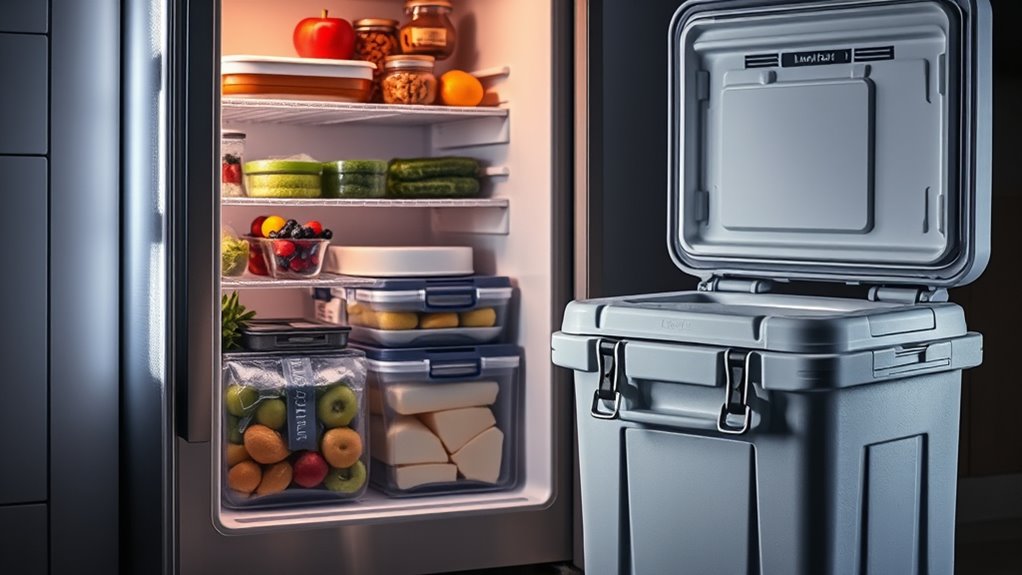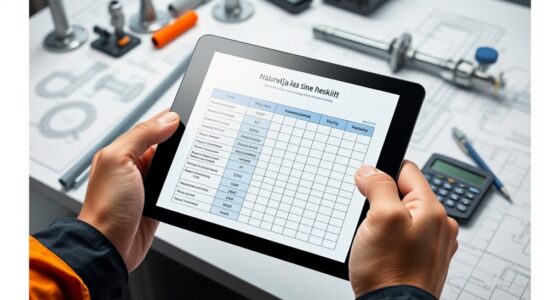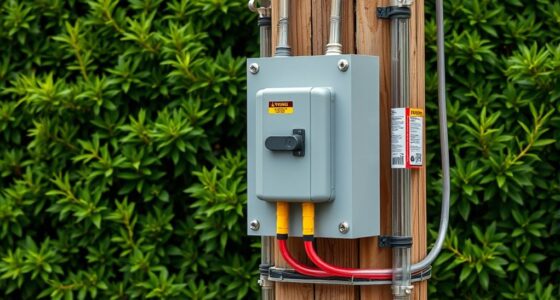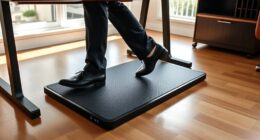During a blackout, keep your fridge and freezer closed as much as possible to maintain cold temperatures. Use ice packs or coolers for essential items, and transfer perishables to the coldest part of your freezer or home areas. Check temperatures regularly and discard food if it smells or looks spoiled. If you want to learn how to extend food safety during outages and restore freshness safely, there’s more to take into account.
Key Takeaways
- Keep refrigerator and freezer doors closed to maintain cold temperatures and prolong food safety during outages.
- Use thermometers to monitor appliance temperatures; discard foods above 40°F for over 2 hours.
- Insulate stored foods with blankets or towels and add ice packs to coolers for extra cold retention.
- Prioritize perishable foods like dairy, meats, and leftovers for early use and transfer to the coldest storage.
- After power restoration, check temperatures and discard any spoiled or unsafe food to prevent health risks.
Assessing the Power Outage Situation

When a power outage occurs, the first step is to determine its scope and duration. You need to find out if it’s localized or affects your entire area. Check your neighborhood’s power company updates or call their emergency line for details. Observe how long the lights stay off and whether neighboring homes have power. This information helps you decide how quickly your food might spoil. If the outage is brief, your refrigerator and freezer will likely stay cold enough. But if it’s prolonged, you must prepare for potential food safety issues. Keep track of the outage’s start time and any updates. Staying informed allows you to make smart decisions about managing your food and minimizing waste. Monitoring temperature fluctuations in your appliances can also indicate how well your food is being preserved during the outage, especially as automated systems may help regulate internal temperatures. Additionally, understanding food safety guidelines can help you determine when food is safe to consume or should be discarded during extended outages. Recognizing signs of spoilage can prevent health risks from consuming compromised foods. Regularly inspecting your stored food for visual changes such as discoloration or mold can further reduce the risk of illness.
Prioritizing Perishable Items
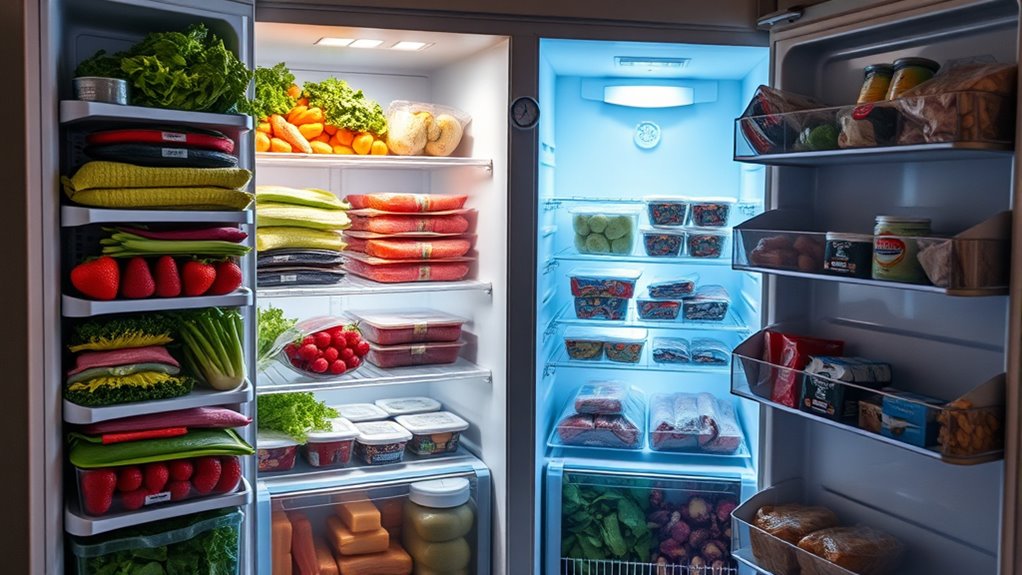
Once you’ve assessed how long the power outage might last, focus on protecting your most perishable foods first. Identify items that spoil quickly, like dairy, raw meats, seafood, and cooked leftovers. These foods require the coldest temperatures to stay safe, so prioritize keeping them cold or using alternative cooling methods like ice packs or a cooler if your fridge isn’t running. Check items with a shallow container, such as salads or cut fruits, and consume them early. If your freezer is full, it can retain cold longer, so avoid opening it unless necessary. Moving perishable items to the coldest part of your home if possible can help maintain their safety, and plan to use or preserve them as soon as possible to prevent spoilage and foodborne illnesses. Proper cold storage techniques can help extend the safety of your perishable foods during outages. Additionally, understanding food safety guidelines ensures you handle foods correctly during such emergencies, and being aware of the effects of temperature on food spoilage can further improve your food safety strategy.
Keeping the Refrigerator Door Closed
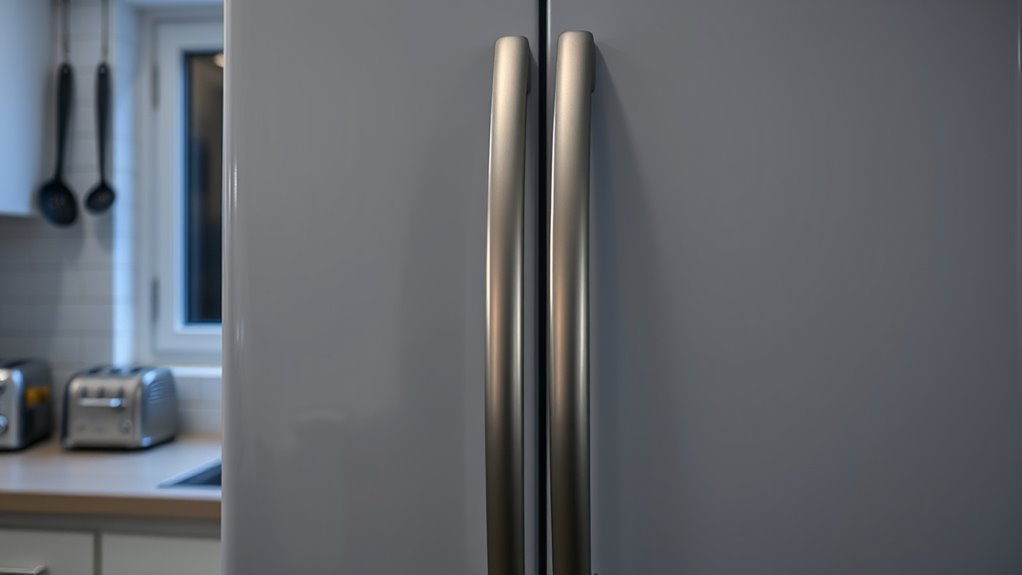
To maximize the cooling time of your refrigerator during a power outage, keep the door closed as much as possible. Every time you open it, warm air enters, causing the temperature inside to rise and shortening the safe storage period. Plan ahead by organizing your items so you can quickly find what you need without rummaging. Use the door’s compartments strategically, placing frequently used items near the front. Avoid opening the door unnecessarily; check the contents quickly and close it again promptly. Remember, a closed door maintains the cold environment longer, helping your perishable foods stay safe. Being mindful of door use during a blackout helps prevent spoilage and reduces waste, giving your food a better chance until power is restored. Additionally, understanding potential risks in merchant services can help you prepare for any disruptions to your supply chain or payment processing that could affect your ability to restock or sell perishable items effectively.
Using Ice to Maintain Cold Temperatures
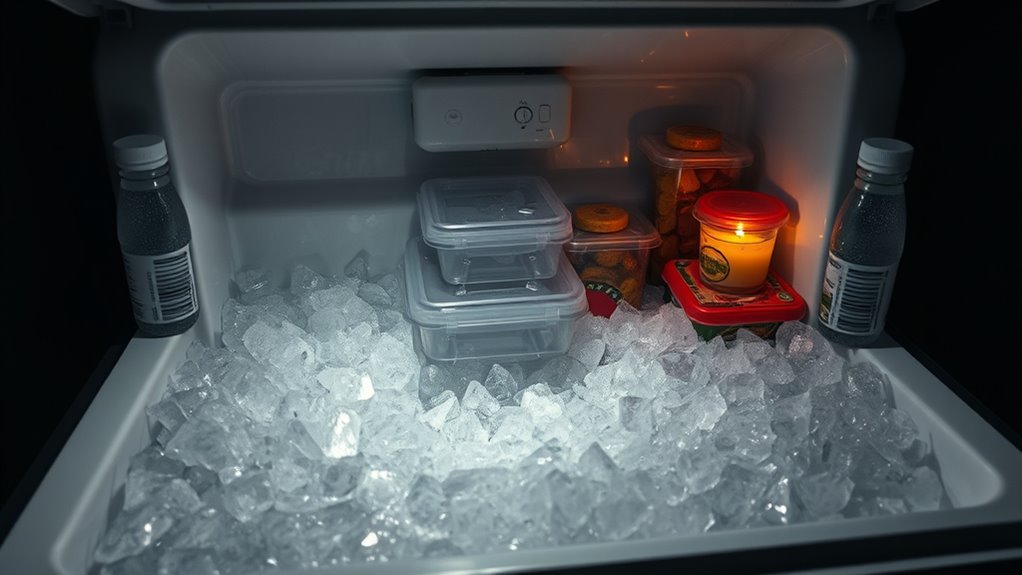
Using ice can help keep your food cold when the power’s out by acting as a cold buffer. It prevents your food from thawing too quickly and helps maintain a safe temperature. Remember to replenish the ice regularly to keep things consistently cold and safe. Additionally, proper insulation upgrades can enhance the effectiveness of your ice buffer by reducing heat transfer and maintaining lower temperatures longer. Improving cooler efficiency through insulation and proper placement can further extend the cold preservation period. Incorporating remote work insights, such as creating a dedicated and well-insulated space, can further improve your ability to preserve food during extended outages. Staying informed about AI advancements can also help you adopt smarter, more efficient preservation methods.
Ice as Cold Buffer
When the power goes out, ice becomes your best tool for keeping perishable foods safe. It acts as a cold buffer, slowing bacterial growth and preserving freshness. To maximize its effectiveness, consider these strategies:
- Layer foods with ice: Place ice around perishable items, especially those most sensitive to temperature rises.
- Use insulated containers: Store ice and foods in coolers or insulated boxes to slow temperature increase.
- Monitor and replenish: Check ice levels regularly and add more as needed to maintain a cold environment.
Preventing Food Thawing
During a blackout, maintaining a low temperature is key to preventing food from thawing and spoiling. You can use ice to help keep your food cold and delay the thawing process. Place ice packs or crushed ice around perishable items in your fridge and freezer. Focus on covering items that are most at risk, like meats, dairy, and leftovers. Keep the ice in sealed containers or bags to prevent leaks and contamination. For added insulation, cover food with blankets or towels to slow heat transfer. The goal is to sustain a temperature below 40°F (4°C). Regularly check ice levels and replenish as needed to maintain consistent cold temperatures. Additionally, understanding temperature control is crucial for effective food safety during power outages.
Replenishing Ice Effectively
To keep your food cold during a blackout, replenishing ice promptly is vital. Fresh ice absorbs heat, slowing temperature rise in your freezer or cooler. To do this effectively, follow these steps:
- Monitor ice levels regularly—add ice before it completely melts to maintain a cold barrier. Recognizing signs of a checked-out partner can help you stay alert to potential issues in your relationship, ensuring emotional support when needed. Maintaining awareness of your appliance’s performance can also help prevent spoilage. Additionally, understanding the best hotels with water parks in Orlando can be beneficial if you’re considering a vacation during power outages, as some hotels offer backup generators and amenities to help maintain comfort. Being aware of common refrigeration problems can help you troubleshoot and address issues promptly to avoid food waste.
- Use crushed ice or blocks strategically—crushed ice cools quickly, while blocks last longer.
- Distribute ice evenly—spread it throughout the freezer or cooler to ensure consistent cooling across all food items. Incorporating insulation techniques—such as wrapping items in blankets or using insulated containers—to help retain cold temperatures longer.
Transferring Food Into Cold Storage
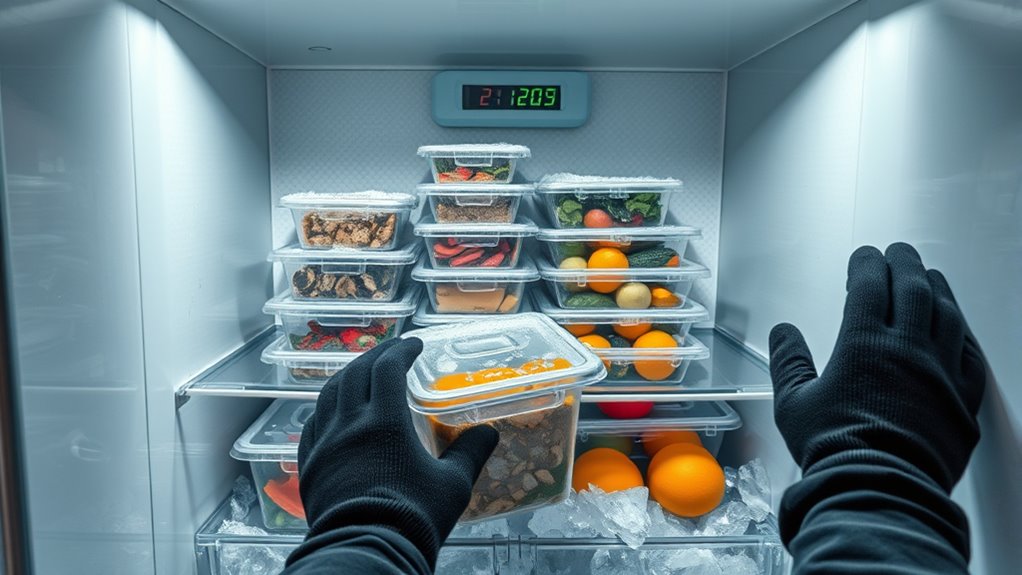
Transferring food into cold storage during a blackout requires careful speed and attention to prevent spoilage. First, gather your frozen items and move them promptly to the coldest part of your freezer, ideally where the temperature remains below 40°F. Use insulated containers or coolers with ice packs to keep perishables cold during transit if your freezer isn’t immediately accessible. Prioritize items most at risk of spoilage, such as meats, seafood, and dairy. Minimize the time food spends out of a cold environment by organizing your transfer process efficiently. Once in the freezer, avoid opening the door multiple times to maintain the cold temperature. Acting swiftly ensures your food stays safe and minimizes waste. For added peace of mind, document your food inventory to keep track of what has been stored and help manage your supplies effectively.
Monitoring Temperatures With a Thermometer
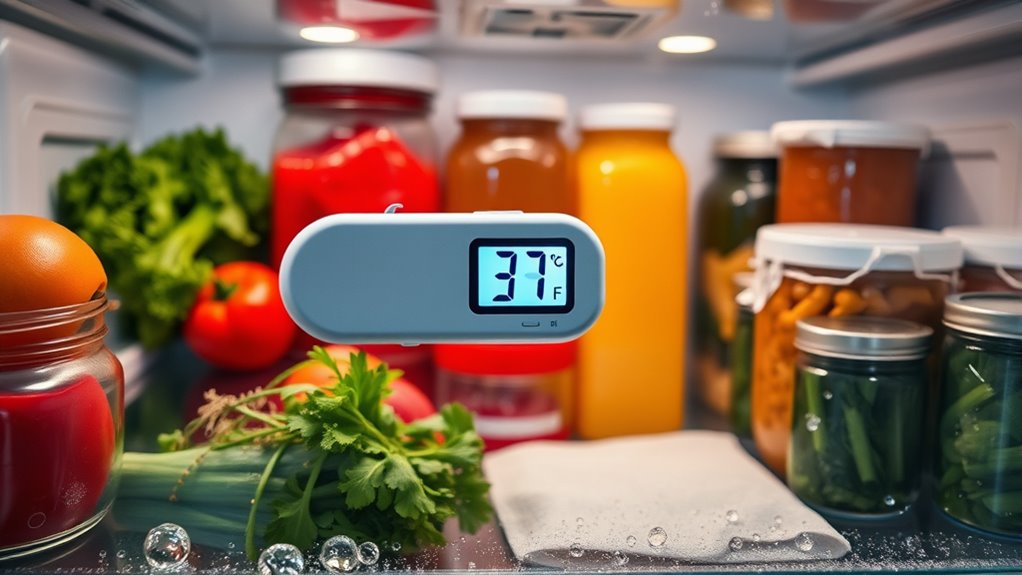
After moving your food into cold storage, it’s important to keep a close eye on the temperature to guarantee safety. Using a thermometer allows you to monitor your fridge and freezer accurately. Place the thermometer in the warmest part of the fridge and the coldest part of the freezer for precise readings. Check temperatures at least once every 4-6 hours during a blackout. To interpret the readings effectively:
- Keep the fridge at or below 40°F (4°C).
- Maintain the freezer at 0°F (-18°C).
- Record each reading to track temperature stability over time.
Consistent monitoring helps you identify potential issues early, preventing spoilage and foodborne illnesses. Adjust storage or take action if temperatures rise above safe levels, ensuring your food remains protected until power is restored.
Determining Food Safety After Power Restores
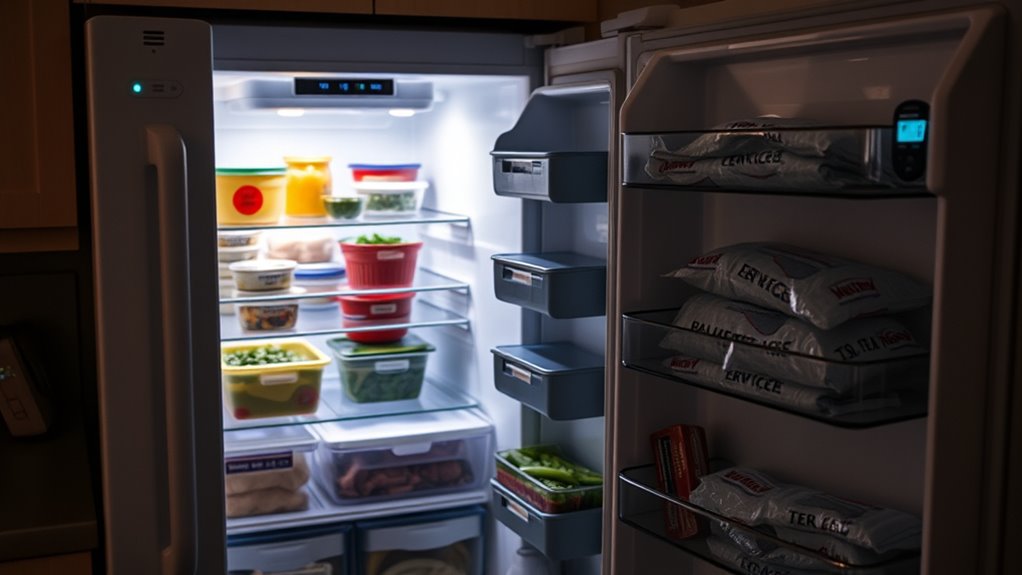
Once power is restored, it’s essential to verify whether your food remains safe to consume before refreezing or eating it. Check the temperature of your refrigerator and freezer with a thermometer. If the fridge is above 40°F (4°C) for more than two hours, perishable food may be unsafe. For the freezer, if items are still frozen or solid, they’re likely safe, but if they’re warm or have thawed completely, discard perishable items like meat, dairy, and cooked leftovers. Look for signs of spoilage, such as an off smell, discoloration, or sliminess. When in doubt, discard questionable items to avoid foodborne illness. Always prioritize safety over waste, and remember that refrigeration and freezing only slow bacterial growth, not eliminate it. Proper temperature monitoring is crucial to assess food safety accurately after a blackout. Considering the cultural and regional breakfast traditions, it’s important to be particularly cautious with perishable ingredients common in various cuisines.
Managing Freezer Items During Extended Outages
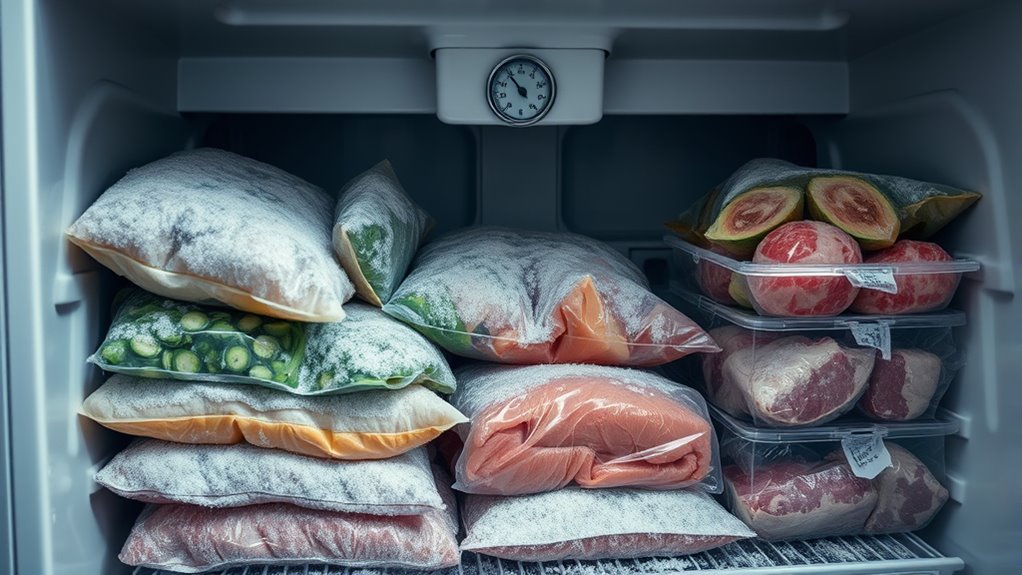
During an extended power outage, it’s essential to manage your freezer items carefully to prevent food waste and guarantee safety. First, keep the freezer door closed as much as possible to preserve cold air. Second, consider transferring items to a cooler with ice if the outage extends beyond 24 hours. Third, monitor the temperature if you have a thermometer; food is safe if it remains below 40°F (4°C). If the freezer is still mostly frozen after 24 hours, it’s best to keep the food stored. Avoid opening the freezer unnecessarily to maintain the cold. When power is restored, check each item’s appearance and smell before refreezing or consuming. Proper management prevents spoilage and minimizes waste during extended outages. Additionally, understanding food safety guidelines can help you make informed decisions about your food during such emergencies, including proper storage techniques and signs of spoilage. Being aware of self-watering plant pots can also be useful for maintaining household plants during emergencies that disrupt regular routines.
Safely Discarding Unsafe Food
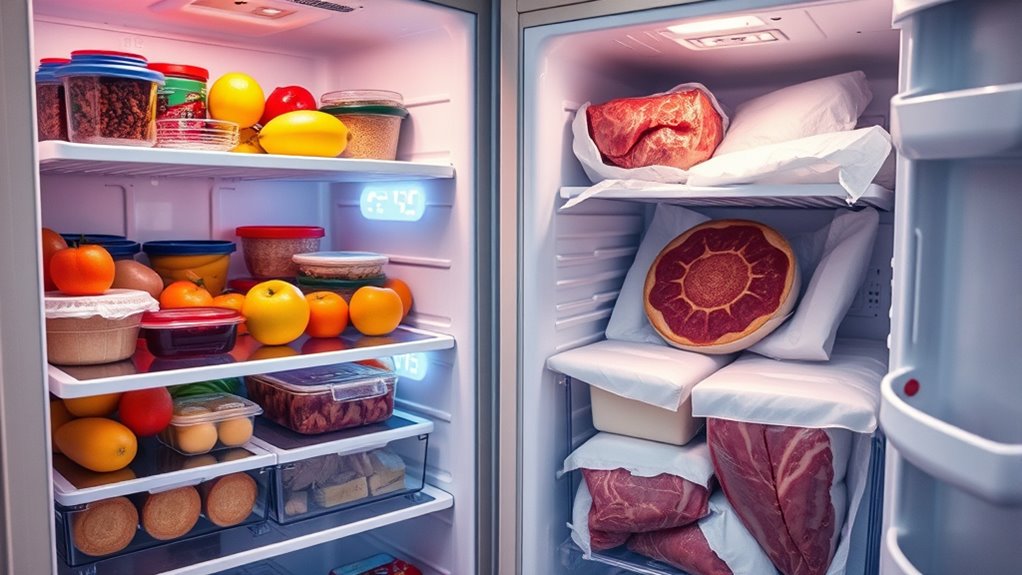
When you suspect that food has been exposed to unsafe temperatures or shows signs of spoilage, it’s essential to discard it promptly to prevent foodborne illness. Look for foul odors, slimy textures, discoloration, or mold, as these indicate spoilage. Don’t taste or smell questionable food; it can be risky. Use gloves if possible to avoid direct contact. Place unsafe food in a sealed bag to prevent leakage or cross-contamination. Dispose of it in an outdoor trash bin if possible, especially if it’s perishable or has been left out for too long. Clean and disinfect the area where spoiled food was stored to eliminate bacteria. Remember, safety comes first—discard any food that might pose a health risk, even if it’s difficult to part with.
Preventing Future Food Safety Risks

To minimize the risk of future food safety issues during blackouts, it’s important to implement proactive measures now. First, regularly audit your fridge and freezer to ensure they operate properly and maintain safe temperatures. Second, stock up on backup power sources like generators or coolers to keep food cold during outages. Third, educate yourself on safe food handling practices, such as freezing leftovers promptly and avoiding the purchase of perishable items close to expiry. Additionally, understanding temperature control can help you better judge when food is at risk of spoilage. Maintaining proper refrigeration is crucial for food safety during power outages, and using reliable thermometers can help monitor temperatures accurately. By staying vigilant and planning ahead, you reduce the chances of foodborne illnesses and spoilage. These steps help you maintain the safety and quality of your food, even when the power goes out unexpectedly. Prevention today guarantees peace of mind tomorrow.
Frequently Asked Questions
How Long Can Food Stay Safe Without Power?
You can typically keep food safe for about 4 hours in a fully closed fridge and up to 48 hours in a full freezer. After that, perishable items like meats, dairy, and leftovers may spoil and pose health risks. To extend freshness, keep doors closed as much as possible, use ice packs, and monitor temperatures. When in doubt, discard anything that looks or smells off to avoid foodborne illnesses.
What Signs Indicate Food Has Spoiled After a Blackout?
If food has spoiled after a blackout, you’ll notice a foul or sour smell, slimy or discolored surfaces, and mold growth. Check for an unusual texture or color change, especially in dairy, meats, and leftovers. If the food is warm to the touch for more than two hours or shows any signs of fermentation, discard it immediately. Trust your senses; when in doubt, throw it out to avoid health risks.
Can I Refreeze Thawed Food Safely?
Yes, you can refreeze thawed food if it’s still cold, firm, and has stayed at or below 40°F, and if you cooked it before refreezing. However, avoid refreezing cooked leftovers that have been sitting out for more than two hours or have an unusual smell or texture. Always check for signs of spoilage before refreezing, and when in doubt, discard the food to prevent foodborne illness.
Are There Any Foods That Should Never Be Refrozen?
You should never refreeze foods like cooked seafood, eggs, or dairy products once they’ve been thawed, especially if they’ve been out at room temperature for over two hours. Also, avoid refreezing produce that’s been thawed and shows signs of spoilage, such as sliminess or an off smell. Refreezing can cause bacteria growth, making these foods unsafe to eat. When in doubt, discard questionable items to keep yourself safe.
How Often Should I Check the Temperature During an Outage?
You should check the temperature every 4 to 6 hours during a blackout. Use a thermometer to monitor your fridge and freezer temperatures, ensuring they stay below 40°F for the fridge and 0°F for the freezer. Frequent checks help you act quickly if temperatures rise, preventing food spoilage. Keep a record of the readings, and if temperatures get too high, prioritize consuming or discarding perishable items.
Conclusion
To keep your food safe during a blackout, stay calm and follow these steps. Prioritize perishable items, keep doors closed, and use ice to maintain cold temperatures. Transfer food to a cooler if needed, and check for signs of spoilage once power returns. If in doubt, discard questionable items to avoid illness. By staying vigilant and prepared, you can protect your food and health, even during extended outages.

